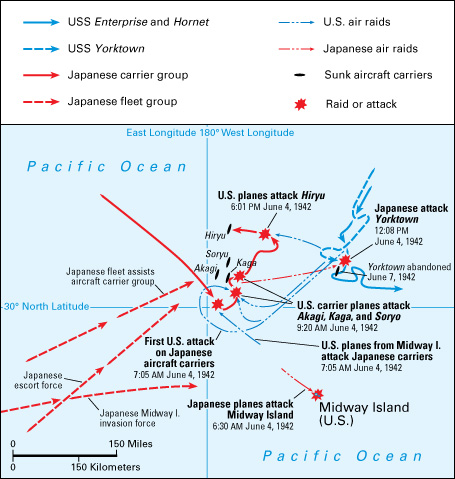Midway, Battle of, was fought between Japanese and United States forces during World War II (1939-1945). The three-day naval battle began June 4, 1942, near Midway Island in the central Pacific Ocean. The American victory in the battle marked a turning point in the war in the Pacific. The battle weakened the Japanese navy and stopped Japan’s advances.

Naval air power was crucial to military success in the Pacific. Japan’s goal at Midway was to take the island’s airstrips and destroy the U.S. Navy’s aircraft carriers. The United States learned of Japan’s intentions and sent a naval force to stop the Japanese.
The battle opened on June 4, 1942, with a Japanese air strike on Midway Island. American bombers responded from the island but damaged no Japanese ships. Three squadrons of U.S. Navy torpedo-bombers—41 aircraft—then attacked the enemy fleet. However, the attack was unsuccessful, and the Japanese shot down 33 of the American planes. A wave of 54 American dive bombers quickly followed and pounded the enemy aircraft carriers. Three Japanese carriers were damaged beyond repair. At nearly the same time, Japanese bombers attacked and severely damaged the American carrier USS Yorktown, which had to be abandoned. Later in the day, American bombers crippled a fourth Japanese carrier.

On June 5, the U.S. Navy chased the retreating Japanese force westward. On June 6, American bombers sank another Japanese warship. A Japanese submarine located the destroyer USS Hammann towing Yorktown and torpedoed both ships. Hammann sank immediately, and Yorktown finally went down early on June 7.
Japan suffered devastating losses in the Battle of Midway. It lost 4 aircraft carriers, about 300 aircraft, and about 3,000 sailors and aviators. American losses included Yorktown and Hammann, about 150 warplanes, and about 300 lives. In 1949, Chicago’s Municipal Airport was renamed Midway Airport in honor of the American victory.
See also Midway Island ; World War II (The war in Asia and the Pacific) .
